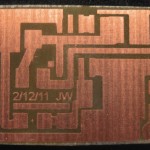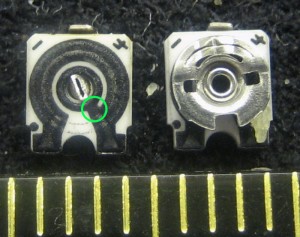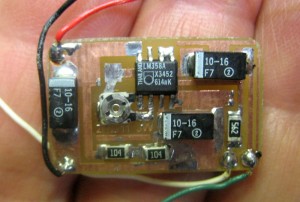Here’s the small board that will implement the extra output amplifier to have the black prototype recording preamp/AGC/limiter thing put out enough that it works with the iRiver T30 recorder without the dumb empty files.
I did go with the tiny trimpot for the feedback resistor, so I can make further adjustments if needed.
It took about 40 minutes from printing the artwork to ready to solder, and another half hour to ready-to-test. (It looks like I was a little aggressive rounding the corners on the belt sander, and I left the part center-marks turned on in the board layout.) Unfortunately, testing wasn’t as smooth as I would have liked. But I learned a lot 😕
Problems, problems, problems Learning opportunities
I hope I learn something from this one: The LM358 is a very old part. I had no business assuming its output would be rail-to-rail, but I did. As soon as I got the amp working, I saw very asymmetric clipping on positive peaks of test sine waves. That finally made me check the specs and learn that the 358’s output voltage swing is about ground (good) to 1.5V below V+ (not so good). In the +/- 15V supplies of olden days, losing 1.5V isn’t much. But when you’re running on 3V and need the biggest swing you can get, it’s critical! Yeah, there might be a 3V, rail-to-rail part with the same pinout, but I can’t get one soon enough. Rats.
When I first tried the board, it just didn’t work. (I still don’t understand all the problems, but the bad pot as feedback resistor – see below – was one critical one.) But eventually it started amplifying, and I moved on to figure out how much gain I needed.
The calibration plan wasn’t too hard:
- Run the amp up at 3V (design minimum) and put a 1KHz sine wave thru it to determine max peak-peak voltage I can get.
- Take a 1KHz sine wave at known amplitude and record it – probably to the “good” recorder.
- Record classical music (large dynamic range) at a couple of levels from pretty low to pretty high (thus well into limiting). I don’t care about the exact levels, and it’s hard to measure music audio levels anyway.
- Look at the recordings. Using the known P-P sine wave, get a voltage to Goldwave scale calibration. Scan all the music recordings for absolute peak. Get a peak voltage reading from that. Now I know worst case peak voltage for audio.
- Compute gain of amp to boost peak audio observed to just shy of max P-P capability of the amp at 3V supply. Use standard op-amp model to compute feedback resistor.
A 1KHz sine wave at 0.2VRMS into the recorder produced waveforms on GoldWave of 0.2 units peak (not P-P). So that’s 0.56VPP in -> 0.2 units P in GW, or 2.8VPP/GWunit.
In a loud section at maybe 4LEDs on the black proto, the recording showed a peak of 0.15 units P. In a loud section with gain on the proto cranked all the way up and only last LED on – there was a peak of 0.32units. So it looks like the black amp is currently able to put out peaks of at least 0.32*2.8=0.9VPP.
Unfortunately, after losing a good volt (the spec was conservative) of P-P swing, I can barely get gain of 2 out of the amp! Much wailing and gnashing of teeth later, I decided to run the amp on 9V, which gives me 7+ volts of swing, enough to run the dumb T30 successfully (I think). But it means I can’t fit it in the original black box, and it will require an additional piece of junk and wires on the table when I’m recording. Ugly.
Before coming to that conclusion, I cast desperately for alternatives. I recalled that I’d put a 5.6K resistor in series with the output of the black proto to guarantee being in spec with the “>5K output load” spec of the 2167. The input impedance of the 790 recorder is 1.8K/channel (recording or not – so I only connect to one channel). If the T30 is similar, I’m losing a lot of precious signal across that 5.6K. The T30 turns out to be about 10K per channel. If I record to both channels, that meets the required load impedance, and I can get rid of the resistor and pick up a little more signal! I pulled the 5.6K. Yeah, that’s building in a dependence on a specific recorder, but I’m getting desperate.
Another alternative was whether I should just accept the fact that I can only record at a much lower level than I’d like. I always do a cleanup pass on the recordings anyway, and normalizing the level is part of that. Is the puny signal I can get out of the black proto at least enough that when I crank it up after the fact I get a not-too-noisy result? The limiting factor is that I must set the record level on the T30 at 21 (out of 31) to avoid the empty files. (I get reasonable recorded level setting it at 29). So I did a test recording (now with the small boost of the removed 5.6K resistor) at level 21. Nothing – no recording at all. It doesn’t matter whether the S/N ratio would still be acceptable – that signal level isn’t enough to trigger the T30 to start recording! I still need more signal. (It also looks like the trigger level is the average of both channels, so trying to save a little by recording only one channel just makes it that much harder to trigger.)
Another possibility is using a transformer on the output. The 2167’s output load is still limited to 5K, and that’s about what I have to drive, so a transformer doesn’t help there. But if I ran the new amp at 3V and even if I got hardly any voltage gain, I would get a much lower output impedance, and thus a power gain. That could drive a transformer to give me more output voltage to the recorder. That’s not off the table, but it would obviously significantly increase the current consumption of the amp. I was pleased that it only drew ~0.5mA – I can afford that. But I guess I’ve gotta pay for the signal I need somehow. Do I have a suitable transformer? How would it affect fidelity? And, of course, it wouldn’t fit in the existing box 🙁
I tried a couple of the small audio transformers I had around. An 8ohm-1Kohm gave the biggest boost, but I could still only get about 1.5V P-P out of it without distortion at 3V compared to 5V P-P from the amp alone with a used-9V 7.5V supply. I guess running the amp on a 9V is the way to go.
Damn. This one cost me hours. What I thought were 50K trimpots and used for the op-amp feedback resistor were in fact 100K variable resistors, with the slider internally tied to one end. I only needed a variable resistor, but Murphy caused me to lay out the board to use the slider and the end it was tied to, resulting in a near-zero ohm resistor. Of course the amp just didn’t work at all. I finally took it off (thank goodness for the hot air!) and tacked on wire leads to another pot – and it worked fine. There had been a series of problems, and after it was all working reasonably, I soldered (what I thought was) a pot back on. Stopped working again, of course. I hot aired it off again and started to look at it more closely. (That was also when I learned the value was not as marked.) It’s tiny – ~3mm wide – and really hard to get meter leads on reliably, but I finally came to believe the slider was tied to one end. I cut one apart – and sure enough, it was (green circle). That one cost me a lot.
I found a way to reorient the non-pot on the pads on the board to connect to the right places, so I put it back in. Connected correctly, it works 🙂 I carefully set it for gain of 5, set the power supply for ~8V and ran some classical music through the proto into the amp. I saw significantly visible clipping on the scope. I could get less clipping by increasing the supply to ~12V, but that’s not the voltage I have available, so it didn’t count, and I went back to 8V. I don’t understand everything that went on, but I adjusted the gain (thank goodness I had the trimmer!) so there was no clipping. When I measured it – the gain was 2.5! A separate box and battery and all it buys me is a lousy gain of 2.5! I did an end to end test through the proto (adjusted to 5-6 LEDs, about what I think it should be) and to the T30 at rec level of 21, playing both some classical music and some square dance calling. The recording was clean – no audible distortion, and at about the level I usually get with my “good” setup (around -23 dB). I found a little project box that looks like it will fit, so I’ll put it all together.
So – I end up with an amp that works, but needs its own 9V battery and a new box. (And a switch and a jack and a cable with a plug.) At least with the 0.5mA current draw, the ~500mAhr of a typical 9V will give a couple of weekends’ battery life.
I’m sort of up against physics – it’s hard to get a very big signal that won’t clip on a 3V supply – and the annoying characteristics of the T30 recorder. So my goal of producing a fairly simple design that I can reproduce at will that’s recorder-hardware-agnostic will be a bigger challenge than I thought. More on the grand project to follow, but at least I think I’ll have something I can use for next weekend.
Just to be honest with myself: The only thing this whole additional amp nonsense bought me was a workaround for the design flaw in the T30 that caused extra empty files. Just because I got a couple on Ebay before I found out about the problem doesn’t mean I should go to huge efforts to make them work. Better to cut my losses and find better recorders.
Update 2/14
The good news is that I’ve saved all the effort of building an enclosure for the little output amp, as I don’t seem to need it after all for two separate reasons.
All my previous reports and tests have been with my red 1GB T30. I also bought a 512MB silver one on Ebay. I just tried that one to see whether it exhibits the empty file retrigger behavior at high record volumes. It doesn’t! Even with rec level at 31 (max) after one file is closed for timeout of quiet, it sits there just like it should, waiting for input before starting the next file. That means I can use that one with the black preamp and no extra output amp and get both no empty files and ideal record level. The one down side is that since it doesn’t support mono recording, it burns thru its 512MB in about the same time as the 790 fills its 256MB. But that 4+ hours is still plenty for any single session.
I misreported that the red T30 uses the average of levels in the two channels to decide when to trigger a recording, and that the signal level from the black proto wasn’t enough to trigger recording at record level 21. It turns out it uses only one channel to trigger recording – and it apparently wasn’t the channel I was using. When I drive both channels (or even the one – ring – it uses), it triggers reliably at rec level 21. The recorded level is considerably lower than I’d like, but when normalized still sounds just fine. That means I can use the red T30 without the new little amp. It’s 1GB, and so even wasting half its memory on stereo, it still records about twice as long as my good 790s.
I’m still unclear on how I came to the wrong conclusion about the channels. I only record one channel (ring) on my 790s, so I set the black proto up to do the same. Testing the two channels separately shows it’s the ring that is used to trigger recording. So I don’t know why it didn’t work before. I am driving both channels now, but specific tests show that’s not necessary to trigger. I just don’t get it.
But it seems to work. I’ll do tests with both T30s and the black proto at a dance tonight (as well as my good 790 to make sure I get a good recording).
Last update
The recordings from the dance were all completely acceptable. I did some with the red one and got low record levels (as expected from setting at 20), but undistorted and completely recoverable. After I switched to the silver one, I got a couple of recordings at excellent level (and undistorted) – but the empty files were there on that one, too! I cranked the level back to 20, and got all subsequent recordings at expected low but acceptable level, and no empty files. So the empty file phenomenon is not limited to the red one, but I can still live with the results.
The little amp that was going to save the world and make recording possible is now relegated to a little plastic bag, hoping it finds some new use someday.




